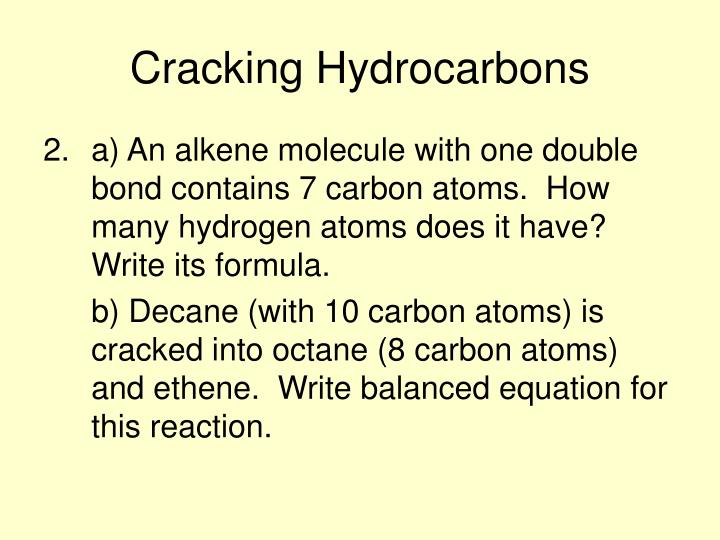Decane Cracking Equation
Decane is cracked to give octane and ethene. Write a balanced symbol equation with state symbols. Chemistry Oil & Organic Chemistry revision notes pages: 1. Fossil Fuels & carbon Cycle: 2. Fractional distillation of crude oil & physical. ALKANES - saturated hydrocarbons, structure, uses.
Introduction There are many different ways in which a large hydrocarbon chain can be broken into smaller hydrocarbons. Within fractional distillation the products obtained in the larger fractioning columns, i.e. The one containing the heavier C 12 to C 20 will subsequently be more beneficial if it is converted into more useful smaller hydrocarbon products. In the HSC course you will be required to know two methods of cracking a hydrocarbon as well as detailed knowledge on fractional distillation.
Thermal Cracking. As shown to the right, thermal cracking is the process of cracking larger molecules by using heat and this case steam. The gas or fine mist of the substance is passed through heat coils, normally this is enough to break bonds between carbons and produce alkyne radicals. Cracking may be cycled until the desired product is acheived. Cracking of Decane Chemical Equations C 10H 22-> 2C 5H 11 (radicals) C 5H 11 (radical) -> C 3H 7 (radical) + C 2H 4 2C 3H 7 (radical) -> C 6H 14 Word Equations Decane -> Pentyl radicals Pentyl radicals -> Propyl radical + Ethene Propyl radical -> Hexane Cracking of Ethane C 2H 6 (g) -> C 2H 4 (g) + H 2 (g) $ Delta$ H = +138 kJ/mol Word Equations Ethane -> Ethene + Hydrogen Catalytic Cracking Catalytic cracking is acheived by the use of a catalyst and lower temperatures. The catalyst used in cracking is zeolite, which is an aluminium silicate.
Zeolite has a high internal surface area due to small open channels and an open-cage structure, this allows the temperature to be around 500 oC instead of the regular 600-800 oC required to thermally crack the same product. Although this saves a lot of energy, only small molecular products due to the small open channel and cage-like structure of zeolite may be obtained. Catalytic Cracking of Decane Chemical Equations C 10H 22 (l) -(zeolite)> C 2H 4 (g) + C 8H 18 (l) Word Equations Decane -(zeolite)> Ethene + Octane HSC Question: Justify the necessity of cracking and describe the purpose in your answer you may include chemical equations and diagrams. Suggested Answer: Justify is to support an argument or conclusion, you must provide evidence for the argument.
Cracking is the process of breaking large hydrocarbon molecules (such as products C 15-C 20 into smaller hydrocarbon molecules such as propene and ethylene. There are two methods of cracking, thermal cracking and catalytic cracking.
In his search for housing, he's introduced to a very cheap boarding house called Yuragi-sou, which was formerly a popular hot springs inn. Shutochnaya prisyaga yubilyara. It's so cheap because the house is haunted by the spirit of a high school student whose corpse was found there.
Thermal cracking involves the use of pylysis coils (heating coils) from which ethane is passed through to produce ethene. C 2H 6 (g) -> C 2H 4 (g) + H 2 (g) $ Delta$ H = +138 kJ/mol Catalytic cracking involves the use of a catalyst in order to reduce the temeperature required to crack the hydrocarbon. Hence a lower temperature of 500 oC is used as opposed to 750-900 oC required for thermal cracking.
